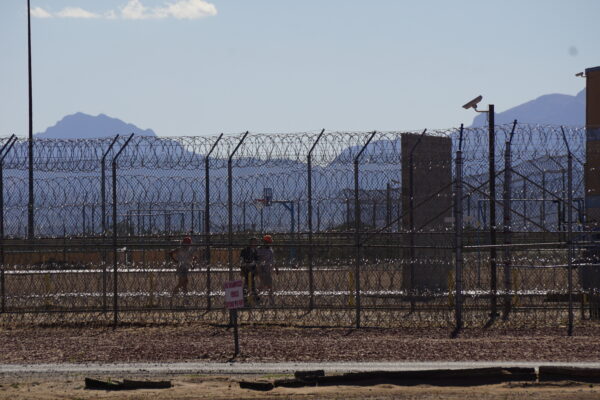It’s been one year and eight months since, at the outset of the COVID-19 pandemic, the ACLU of New Mexico first sounded the alarm of an impending humanitarian crisis for incarcerated people in the state.
We wish we could report that public officials heeded our warnings and implemented adequate measures to mitigate viral spread in carceral facilities. But despite multiple letters to public officials, consistent media interviews, and several lawsuits, including a class action lawsuit on behalf of incarcerated people, COVID-19 gained a foothold in jails, prisons, and immigration detention centers throughout New Mexico.
Though the Lujan Grisham administration did take some steps — like allowing for the early release of a very small number of incarcerated people and putting incarcerated people in an early category of eligibility for the vaccine — not enough has been done.
In August 2020, COVID-19 infection rates were so high in correctional facilities that the Legislative Finance Committee found “an inmate in New Mexico was more than twice as likely to die from COVID-19 than the national average.”
As of this writing, 3,103 people — more than half of the state prison population — have contracted COVID-19, according to the Corrections Department website. At least 28 of those people have died.
Our state can, and should, do better. As we look back on the last year and eight months, here are three important lessons New Mexico should learn from this pandemic.
Lesson One: Mass incarceration is toxic for those behind bars and communities at large
At the outset of the pandemic, public health officials warned that detention facilities would be tinderboxes for infection, pointing to overcrowding, the inability to social distance, inadequate access to hygiene products, and substandard healthcare. Among their recommendations was the immediate reduction of people in jails, prisons, and immigration detention facilities.
Unsurprisingly, states were slow to take public health experts’ recommendations. For months, correctional facilities were at the top of The New York Times’ list of largest outbreaks. Those outbreaks quickly spread to surrounding communities. A Prison Policy Initiative study, which looked at COVID-19 infection spread from May to August 2020, found COVID-19 infections were much higher in counties and multicounty areas with larger incarcerated populations, estimating that “mass incarceration resulted in 560,000 additional COVID-19 cases nationwide” in those three months alone.
New Mexico imprisons people at a higher rate than most U.S. states and every other democracy in the world, putting the state at an even greater risk for rapid viral spread in jails, prisons, and immigration detention centers.
As expected, once New Mexico had its first case in a state prison, the numbers exploded rapidly. On May 15, the New Mexico Corrections Department (NMCD) announced that an incarcerated person tested positive in one of the state’s eleven prisons, the Otero County Prison Facility (OCFP). In a little over a month, OCPF reported over 400 cases. At the facility’s peak, over 90% of the incarcerated population was infected. The virus had also spread to an unreported number of staff at the facility, who live in surrounding communities. As experts predicted, New Mexico’s jails, prisons, and ICE detention centers all experienced large outbreaks, which likely fueled outbreaks in the surrounding areas.
While Governor Lujan Grisham’s April 2020 executive order allowing for the release of some non-violent offenders who were within 30 days of the end of their sentences was a step in the right direction, the measure did not result in the level of decarceration needed to adequately protect people.
As of September 2021, only 550 incarcerated people had been released since the order was first issued. Most of those individuals were released only a week or two early, making the impact on the overall population of the prisons negligible. Under existing laws, the state could have safely released many more people, including people serving sentences as a result of technical parole or probation violations, people within 12 months of release, and elderly people.
Throughout the pandemic, we have received dozens and dozens of calls and emails from desperate family members who have watched in fear as facilities that detain their vulnerable loved ones have experienced unchecked COVID-19 outbreaks.
Lesson Two: Carceral facilities are not set up to care for people in emergencies
In the last decade, the New Mexico Corrections Department has contracted with three different prison medical providers, all of which have been repeatedly sued for medical negligence. Corizon Health, which contracted with NMCD from 2007 to 2016, was sued over 150 times. Centurion Health, which contracted with NMCD from 2016- 2019, was sued 65 times. The current provider, Wexford Health Sources, previously held a contract with Mexico from 2004-2007, but was fired over concerns about care and staffing shortages and after 53 incarcerated people sued. Despite previous issues with the company, Wexford Health Sources received a new contract with the state in 2019.
State prisons are not the only facilities to make headlines for medical neglect. County jails throughout New Mexico, as well as all three ICE detention centers, have been the subject of lawsuits alleging denials of medical and mental health care.
The ACLU of New Mexico has represented many incarcerated clients over the years who were denied care they urgently needed. Those clients include: a woman incarcerated in a state prison who developed advanced endometrial cancer after staff ignored her irregular vaginal bleeding and refused to take her for a biopsy; a Guatemalan man who sought asylum in the U.S. after gang members beat him nearly to death and then was denied medical treatment in ICE detention in Otero County for nearly two years; and a political activist from the Democratic Republic of Congo (DRC) who was beaten, tortured, and imprisoned for his opposition to the current dictatorship there and then denied medical treatment in Torrance County.
The COVID-19 explosion in New Mexico carceral settings happened against this backdrop of callous indifference and medical neglect.
Lesson Three: Incarcerated people need more avenues for justice
In August 2020, the ACLU of New Mexico joined international law firm Faegre Drinker, Albuquerque-based Law Office of Ryan J. Villa, the New Mexico Criminal Defense Lawyers Association (NMCDLA), and several incarcerated individuals in filing a class-action lawsuit against the State of New Mexico for failing to protect the lives and constitutional rights of people detained in the state’s prison system during the COVID-19 pandemic. The First Judicial District Court dismissed our case on procedural grounds, specifically citing the “exhaustion of remedies” clause in state law. Under both state and federal law, incarcerated people are required to go through an internal grievance process prior to filing suit.
The NMCD grievance procedure states that it may take up to “90 working days” from the time a grievance is filed until the final decision on appeal. Incarcerated people who are in desperate circumstances, such as a deadly pandemic, cannot wait three months for help.
Our class-action lawsuit was eventually escalated to the New Mexico Supreme Court, which after almost a year has still yet to issue a decision regarding whether this grievance requirement must have exceptions for emergencies. In the meantime, incarcerated people continue to be forced to go through a grievance process that is lengthy, very unlikely to go in their favor, and often results in retaliation before they can go before a court and assert their constitutional rights.
The New Mexico Prison & Jail Project was created last year precisely because incarcerated people have so few avenues for seeking redress for abuse and mistreatment. Steve Allen, the organizations’ director, speaks to incarcerated people and their families every week and says that incarcerated people are “natural organizers,” but face a system that is designed to keep them from being heard.
“Exhibit A is the grievance system in all of these facilities,” said Allen. “The law around this is that they are supposed to have some access to raise complaints, but often those complaints quite frankly just go in the garbage, they go unanswered, and they are systematically ignored.”
The New Mexico Prison & Jail Project has filed many records requests in the last several months to gain a better understanding of the kind of grievances that have been filed. Yet, grievances that the organization knows have been filed — like those related to a rodent infestation that incarcerated people have been complaining about for years at Western New Mexico Correctional Facility — have not materialized as a result of their records requests.
As long as incarcerated people are required to exhaust administrative remedies before they can file suits, they will not have access to real or timely justice. Even if the barriers to formal lawsuits are diminished, individual lawsuits are a stop-gap measure of accountability in a system that is otherwise left to police itself. Most incarcerated individuals whose rights have been violated will never see their day in court. Independent oversight of New Mexico’s carceral facilities, such as the corrections ombudsman proposed in legislation in 2020, is needed to address the widespread injustices inherent in the system.
Conclusion
The coronavirus crisis has shone a new light on the human cost of our country’s obsession with mass incarceration. Relying on a system that tears families apart and fuels racial injustice to improve public safety has always been foolish, unjust, and counterproductive. But now, in the age of COVID-19, we see even more clearly that mass incarceration is an urgent threat to public health.
Going forward, we can stop stuffing our prisons with people who violate their conditions of parole by missing an appointment or failing a drug test, and instead, treat their mistakes as a public health issue. We can finally admit that locking people up should be a last resort, and that tackling the root causes of crime through treatment and prevention should be our top priority. And we can stop putting migrants seeking safe refuge in our country in carceral settings while their immigrations cases proceed. If we make these changes today, they will lead to much healthier communities tomorrow.
While the first order of priority should be to decarcerate, measures must also be taken to improve access to care for those people who will remain in correctional facilities. These should include moving away from private prison companies and private health care providers, which are incentivized to cut medical staffing and deny care to maximize shareholder return; ensuring people have access to timely, appropriate, and quality care, and ensuring adequate oversight and accountability measures are in place to monitor the quality of care.
Finally, it’s time we remove legal barriers that prevent incarcerated people from seeking and accessing justice. Grievance processes within jails, prisons, and immigration detention centers are so unreliable that, in effect, they are non-existent. Incarcerated people must be able to access the courts and seek redress for rights violations without having to jump through hurdles that are designed to keep them silent and to keep the public from understanding the true costs of mass incarceration.




